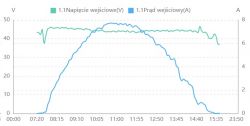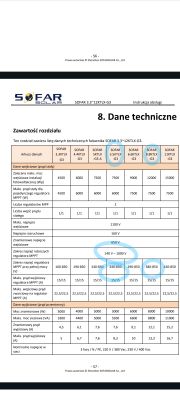Imagine a 4kw system based on two strings of eight 250W panels each.
There are two types of panels to choose from, one with Vmp = 30v, Voc = 37V. The second type is Vmp = 49V, Voc = 60V.
The efficiency of the panels is omitted or assumed to be the same.
We assume that the currents are within the operating range of the inverter.
We assume that the operating range of the inverter is 200-500V (*) at nominal power, its maximum voltage is 550V, and the starting voltage is 150V.
The first set of panels will therefore operate in the range of 208-328V (taking into account the temperature coefficients 8 * 26V - 8 * 41V).
The second set will operate in the range of 334-528V (8 * 42V - 8 * 66V), which is at the limit of the inverter's voltage withstand (*).
We read from the chart that in the entire power range the inverter achieves the highest efficiency at 370V (97.5%). At 200V its efficiency decreases by 1.5%, at 530V by 0.5%
Conclusion number one: assuming that the entire system will most often operate at a voltage around Vmp, a set of panels with a higher nominal voltage should give better efficiency (97.5% vs 96%, i.e. about 50 kWh per year).
Conclusion number two: higher voltage-> lower current-> lower cable losses
Conclusion number three: System number two will turn on the inverter faster in the morning when the light is still low, because:
Vst / panel 150V / 8 = 19V.
19V = half the Vmp of panels 1
19V = one-third of the Vmp of the panels 2
(*) We also have an alternative inverter 150-580V, max 600V
Do I understand correctly or do I still have to read?
There are two types of panels to choose from, one with Vmp = 30v, Voc = 37V. The second type is Vmp = 49V, Voc = 60V.
The efficiency of the panels is omitted or assumed to be the same.
We assume that the currents are within the operating range of the inverter.
We assume that the operating range of the inverter is 200-500V (*) at nominal power, its maximum voltage is 550V, and the starting voltage is 150V.
The first set of panels will therefore operate in the range of 208-328V (taking into account the temperature coefficients 8 * 26V - 8 * 41V).
The second set will operate in the range of 334-528V (8 * 42V - 8 * 66V), which is at the limit of the inverter's voltage withstand (*).
We read from the chart that in the entire power range the inverter achieves the highest efficiency at 370V (97.5%). At 200V its efficiency decreases by 1.5%, at 530V by 0.5%
Conclusion number one: assuming that the entire system will most often operate at a voltage around Vmp, a set of panels with a higher nominal voltage should give better efficiency (97.5% vs 96%, i.e. about 50 kWh per year).
Conclusion number two: higher voltage-> lower current-> lower cable losses
Conclusion number three: System number two will turn on the inverter faster in the morning when the light is still low, because:
Vst / panel 150V / 8 = 19V.
19V = half the Vmp of panels 1
19V = one-third of the Vmp of the panels 2
(*) We also have an alternative inverter 150-580V, max 600V
Do I understand correctly or do I still have to read?




